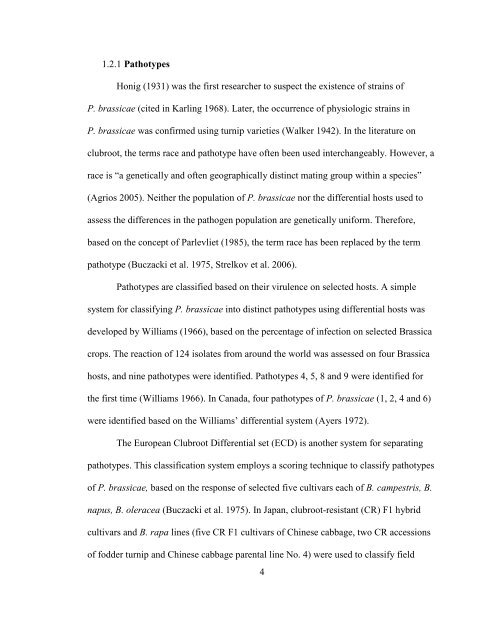Hema Kasinathan Thesis May 1 2012.pdf - Atrium - University of ...
Hema Kasinathan Thesis May 1 2012.pdf - Atrium - University of ...
Hema Kasinathan Thesis May 1 2012.pdf - Atrium - University of ...
Create successful ePaper yourself
Turn your PDF publications into a flip-book with our unique Google optimized e-Paper software.
1.2.1 PathotypesHonig (1931) was the first researcher to suspect the existence <strong>of</strong> strains <strong>of</strong>P. brassicae (cited in Karling 1968). Later, the occurrence <strong>of</strong> physiologic strains inP. brassicae was confirmed using turnip varieties (Walker 1942). In the literature onclubroot, the terms race and pathotype have <strong>of</strong>ten been used interchangeably. However, arace is “a genetically and <strong>of</strong>ten geographically distinct mating group within a species”(Agrios 2005). Neither the population <strong>of</strong> P. brassicae nor the differential hosts used toassess the differences in the pathogen population are genetically uniform. Therefore,based on the concept <strong>of</strong> Parlevliet (1985), the term race has been replaced by the termpathotype (Buczacki et al. 1975, Strelkov et al. 2006).Pathotypes are classified based on their virulence on selected hosts. A simplesystem for classifying P. brassicae into distinct pathotypes using differential hosts wasdeveloped by Williams (1966), based on the percentage <strong>of</strong> infection on selected Brassicacrops. The reaction <strong>of</strong> 124 isolates from around the world was assessed on four Brassicahosts, and nine pathotypes were identified. Pathotypes 4, 5, 8 and 9 were identified forthe first time (Williams 1966). In Canada, four pathotypes <strong>of</strong> P. brassicae (1, 2, 4 and 6)were identified based on the Williams’ differential system (Ayers 1972).The European Clubroot Differential set (ECD) is another system for separatingpathotypes. This classification system employs a scoring technique to classify pathotypes<strong>of</strong> P. brassicae, based on the response <strong>of</strong> selected five cultivars each <strong>of</strong> B. campestris, B.napus, B. oleracea (Buczacki et al. 1975). In Japan, clubroot-resistant (CR) F1 hybridcultivars and B. rapa lines (five CR F1 cultivars <strong>of</strong> Chinese cabbage, two CR accessions<strong>of</strong> fodder turnip and Chinese cabbage parental line No. 4) were used to classify field4
















